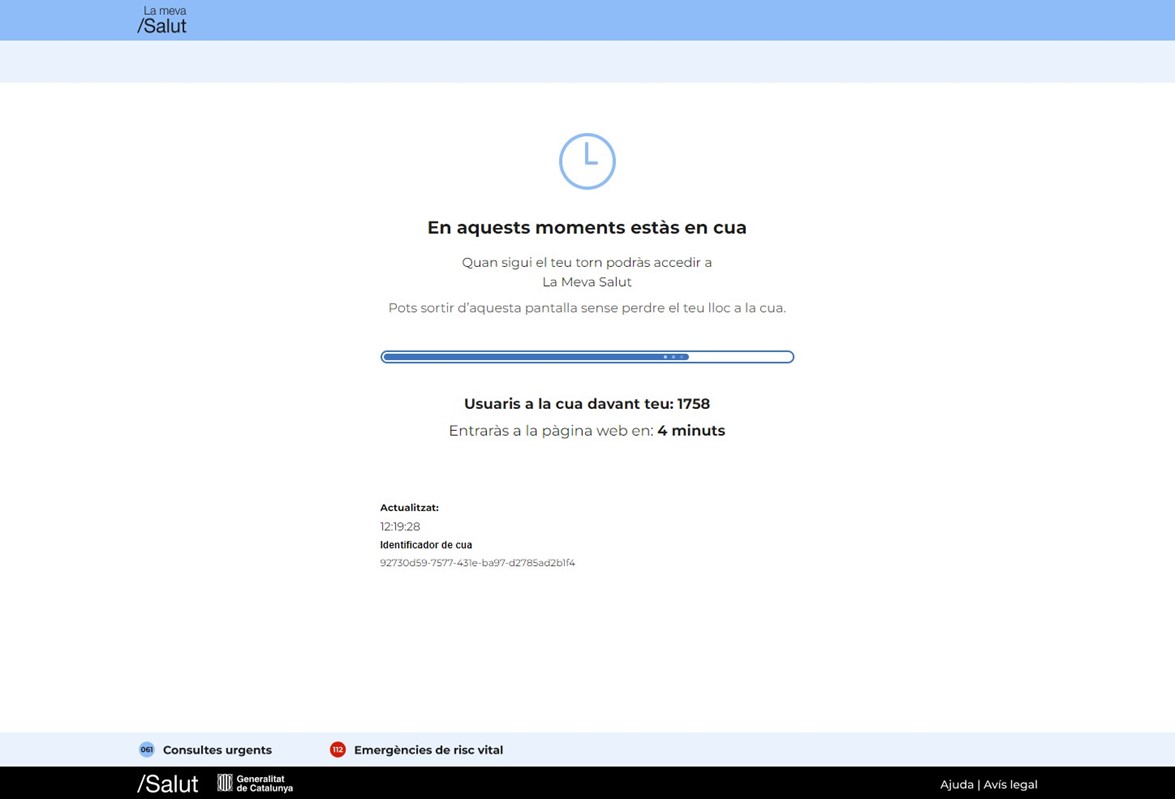How the Catalonian Government delivers reliable digital services with Queue-it

CTTI is behind the Catalonian Government’s digital transformation. Their leadership and collaboration with several government departments ensures effective digital service delivery for over 7 million Catalonian citizens. But demand for digital services reached new heights when COVID hit. Discover how CTTI used Queue-it to handle surging demand and how the virtual waiting room has since become a critical tool used by 10 Catalonian public departments for service delivery.
100%
uptime
ensuring citizens get 24/7 reliable access to digital services
500M+
visitors
through the virtual waiting room with a fair & transparent user experience
3+
years
of Queue-it supporting the government's digital transformation
The Catalonian Government (Generalitat de Catalunya, or GENCAT) delivers digital services ranging from tax filing to university applications to subsidy registrations—and CTTI is there to support them all.
CTTI, the Telecommunications and Information Technology Center of the Catalonian Government, is a public entity established to integrate all of Catalonia’s computing and telecommunication services under a single structure.
“It’s the Catalonian Government’s mission to redefine services to offer both citizens and businesses full digital service delivery,” says Santiago Aguilera Moreno, IT Systems Architect at CTTI. “We’re responsible for the direction, planning, management, and control of all the computing systems and telecommunication services for the region.”
The systems supported by CTTI serve two constituencies. First, the department employees, who access the systems in their daily work. And second, the 7+ million citizens of Catalonia, who increasingly rely on digital channels to access critical services and interact with the public sector.
Discover how Queue-it´s virtual waiting room has become a critical tool for CTTI to support the Catalonian government’s digital service delivery, after successfully handling surging demand for digital services during the pandemic.
“One of the biggest barriers to moving services online is what I call the ‘fear of the unknown’,” says Aguilera Moreno. “What will be the uptake of the digital service? How will users interact with the systems? Will there be peaks and troughs in the activity level, or constant usage? And how will these assumptions hold up in three, five, seven years?
“There are so many questions you just can’t answer confidently until you deploy service to the public. We try to predict user load and behavior when we build a system. But it’s a delicate balance to make a system as scalable as possible without wasting taxpayer money by investing in capacity that isn’t needed.”
CTTI developed many of its systems around 2010, based on the usage levels and consumer behavior of the time. To ensure robust data security, they built and maintained many of these systems on premises.
But demand for digital service delivery has grown rapidly since 2010. And when the pandemic hit in 2020, it turbo-charged the scope and scale of Catalonia’s digital public service needs.
“The first digital service we needed to deploy during the pandemic was for citizens and businesses to apply for economic relief,” says Aguilera Moreno. “We built a scalable system for relief applications, and increased the resources for our application platform.
“In the past, we’ve successfully supported the application process with just one or two virtual servers. But we knew demand would be high, so we scaled from two to four for the first round of applications. Despite the extra capacity, the system was unable to support the level of transactions.
“We scaled to eight servers the next day, so quadrupling the capacity, and even still it was difficult to support the demand. The team spent the morning rebooting overloaded servers. Horizontal scaling and system changes we’d normally do in weeks or months were done overnight, directly in production. It was an extraordinary situation,” says Aguilera Moreno.
The response from stakeholders was not positive. “There were some really harsh criticisms and understandable frustration from citizens,” says Aguilera Moreno. “CTTI is supposed to have enough muscle to deliver robust solutions—that’s what we pride ourselves on. But the demand was unprecedented.
“It’s not trivial to scale systems,” says Aguilera Moreno. “It’s not just about adding servers, it’s also about expanding the load balancers and working around bottlenecks or third-party dependencies that might also have similar scaling challenges.”
CTTI saw their second surge of COVID-related demand when they released services for vaccination bookings and vaccination. They were better prepared for demand this time, but the challenges of scaling continued.
“There was immense pressure to improve the situation to ensure the systems didn’t crash again when the next round of applications opened up,” says Aguilera Moreno. “Ultimately, we lacked a way to control the level of traffic through our systems, and without that it was truly an impossible feat trying to get systems to run faster and faster.”
In early 2021, CTTI discovered the solution to their traffic control problems in Queue-it’s virtual waiting room. Their most pressing need was to protect vaccination registrations and government relief payments, so they quickly implemented the waiting room into the user journey for these services.
“We set up a waiting room in front of the front-end and the transactional portions of the user flow, which gave us full confidence there wouldn’t be service interruptions,” says Aguilera Moreno.
“The ease of integration and dedicated support were outstanding,” says Aguilera Moreno. “We could tell we were in good hands.”

Chart showing large sudden traffic spikes to CTTI's systems during vaccination registrations
Despite traffic peaks of over 4,000 visitors per minute, the vaccination registration portal remained online, citizens got fair and smooth access, and CTTI’s teams didn’t have to work frantically to put out fires.
“Queue-it helped us deploy controlled digital services that kept us out of the news, brought a sense of calm to our organization, and ensured we worked as efficiently as possible.”
Santiago Aguilera Moreno, IT Systems Architect

“The waiting room is a fantastic communication tool to set expectations for citizens, assuring them they’re in the right place and showing them the progress, they’re making,” says Aguilera Moreno.

Custom queue page for "La Meva Salut", Catalonia's digital health service portal
Using a SaaS tool like Queue-it gave CTTI access to technical expertise, ensured a superior citizen experience, and saved time and resources, says Aguilera Moreno.
“As peak traffic specialists with a large customer portfolio, Queue-it has a bigger picture perspective on product needs and user experience. They bring that expertise to bear and enhance the product in a way we couldn’t have done with custom development.”
“Queue-it saves us on scaling costs. But also, relative to building our own solution, it saves us immeasurable hours of work. We didn’t have to waste time creating specifications and reviewing bids for the project, purchase the additional server space to host the visitors, or do all the ongoing maintenance work. With Queue-it, I don’t have to manage the infrastructure, the platform, or the communications. All I need to manage is the subscription.”
Typically, the advantage of in-house traffic management is controlling the security and data compliance of the solution. But with Queue-it’s robust security measures and strict compliance with regulations, CTTI protected their services without fear of exposing citizen data, says Aguilera Moreno.
“The security and compliance of Queue-it ensured we met the strict GDPR and privacy regulations of the public sector. Because Queue-it works with HTTP redirects, we knew we weren’t exposing any sensitive data, which is crucial since we’re dealing with sensitive medical and financial information.”
After several successful large-scale public registrations with Queue-it, online traffic control became CTTI’s lynchpin in deploying digital public services with confidence.
As of this story’s writing, 10 different areas of the government are using Queue-it for everything from tax filing to health appointment bookings to general 24/7 downtime protection from unexpected traffic surges.
“When other departments saw how smoothly the vaccination and relief registrations went, they were all asking us how they could use Queue-it for their services,” says Aguilera Moreno.
Now, when a new or updated service has a “go-live” date, the CTTI team knows website overload won’t stand in the way of delivering the service. “Queue-it’s robustness means we can guarantee our teams can deploy a service, and if it needs to be operational by a certain date, we just say, ‘Ok. Roger that,’ without the fear systems will fail” says Aguilera Moreno. “For us it’s a huge win to breathe easy on these high-stress days.”
“We’re no longer uncertain about the robustness of our systems in the face of high demand. Whatever the systems can handle, we use Queue-it to keep inflow at that level.”
Santiago Aguilera Moreno, IT Systems Architect

The Department of Education, for example, implemented Queue-it after the transition from a fully in-person to fully online process for university enrollment. The virtual waiting room is used to ensure a smooth experience for eager students during the first and last days of the enrollment period, which attract large spikes in activity.
“Each use case has a different team and technical setup and requirements, and Queue-it has adapted the virtual waiting room to each situation to a high professional standard,” says Aguilera Moreno.
“Queue-it has been an indisputable success story for us and has become a vital tool for ensuring we deliver reliable digital public services at scale.”
Santiago Aguilera Moreno, IT Systems Architect
With the confidence that high load won’t crash their systems, the CTTI team can return their focus to improving the experience once visitors get access to the services.
“Our work is never done. Queue-it removes the pressure and lets us focus on optimizing the experience. We can always improve things to get visitors through faster and decrease wait time. But now we know the systems won’t fail, which is the worst thing for citizens and where we feel the most pressure,” says Aguilera Moreno. “Traffic control gives us the luxury to put our resources into the projects we see as critical to increasing digital service adoption.
“Our mission hasn’t changed,” says Aguilera Moreno. “We continue to focus on our mandate to digitalize service delivery and give citizens a great experience when interacting with their government. We have many exciting projects in the pipeline to do that,” he says.
“The virtual waiting room is a key tool on our digital transformation journey and gives us the control we need to deliver reliable services well into the future.”